Are you a Quiet Speculation member?
If not, now is a perfect time to join up! Our powerful tools, breaking-news analysis, and exclusive Discord channel will make sure you stay up to date and ahead of the curve.
When you talk to players about their Modern decks, most of them can tell you why they like their deck. Perhaps the play patterns fit their style or they have good things to say about the deck's relative power level. This is good information to have—but identifying a deck's weaknesses is more important when it comes to assessing a deck's position in the metagame. It's also the less popular element to focus on.

At the tail end of Brian Braun-Duin's most recent article on Channel Fireball, he discussed why he likes Bant Eldrazi in Modern. In his estimation, one of the major draws to the archetype is its relatively small number of bad matchups. This approach makes a lot of sense. Having a lot of favorable matchups is nice, but needing to dodge half of the room (or some other major percentage) at any given tournament is a serious problem. Players will frequently oversimplify the Modern format and say they're playing their deck because, for example, they beat Infect, Dredge, and Jund. What they're not saying is what they lose to—and Modern is too diverse to be sold on a few good, if popular, matchups.
I have solidified myself as a Delver player in Modern, and I have a lot to say about the strengths of the deck. But its few weaknesses is what has always mattered most to me. Given the non-rotating nature of Modern, it's important to know a given deck's weaknesses so that you can identify how good that deck is with regard to the current state of Modern. Today I'll break down the three major types of weaknesses that a deck can have and share some strategies for mitigating them.
[wp_ad_camp_1]
Inconsistency: Losing to Yourself
Inconsistency is the fundamental weakness that is typically most damning for a deck. If your deck can't consistently execute its game plan, sometimes you can get crushed in a tournament despite getting supposedly favorable pairings. The best example of a deck like this in Modern is Bogles. 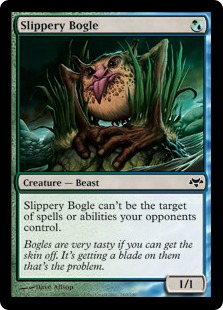 The deck does something that is quite powerful and generally difficult to interact with, but it has a considerable fail rate. It has to mulligan more than most decks, and it doesn't mulligan particularly well. When your deck can lose to itself, you have to believe that you'll face almost exclusively positive matchups to like your odds to win a tournament.
The deck does something that is quite powerful and generally difficult to interact with, but it has a considerable fail rate. It has to mulligan more than most decks, and it doesn't mulligan particularly well. When your deck can lose to itself, you have to believe that you'll face almost exclusively positive matchups to like your odds to win a tournament.
Ad Nauseam is another deck that I would lump into this category. It is more consistent than Bogles. But it still relies on drawing very specific cards, without much in the way of card selection. It also has almost no way to protect its combo or disrupt an opponent. There are plenty of other fringe decks to toss in this category as well, but I would say that Ad Nauseam and Bogles are the two most visible examples of decks of this nature.
Notably, when you evaluate your deck's bad matchups you have to pay a lot less mind to decks of this nature than you do to more consistent decks. If your deck is bad against Bogles, you can take some solace in the fact that they'll just lose more often than most decks. If you have a sideboard slot that's up in the air and you're deciding between a card against an inconsistent deck or against a consistent one, it's almost always better to choose the latter. Bogles is on the bad side of matchups for Grixis Delver—but it also accounts for one of the handful of times that I've mulligained to four and beaten a seven-card hand. Don't overcommit sideboard space to these archetypes.
Bad Matchups
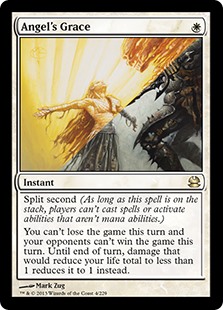 Every deck has some bad matchups, but some a lot more than others. A subdivision here is the matter of whether your deck is weak to categories of decks or specific archetypes. Is your deck bad against all control decks, or is there a particular one that gives it trouble? Do all of the linear aggressive decks beat up your strategy, or only some number of them? For example, Ad Nauseam is weak against Infect while still beating up on the other aggressive strategies, due to the particulars of how Angel's Grace works.
Every deck has some bad matchups, but some a lot more than others. A subdivision here is the matter of whether your deck is weak to categories of decks or specific archetypes. Is your deck bad against all control decks, or is there a particular one that gives it trouble? Do all of the linear aggressive decks beat up your strategy, or only some number of them? For example, Ad Nauseam is weak against Infect while still beating up on the other aggressive strategies, due to the particulars of how Angel's Grace works.
A bad matchup against a whole category of archetypes is a significantly different problem than a bad matchup against one deck. If your deck is bad against linear aggressive decks, then playing some number of removal spells in your sideboard makes sense. If your deck has bad matchups consisting of specific archetypes that attack in different ways, you have to get more creative. Assume that my deck is weak to Dredge, Jund, and Tron. There isn't going to be an elegant way to solve all of these problems with a small number of sideboard cards.
If you're bad against big mana decks, Crumble to Dust is a reasonable sideboard option. If you're good against Valakut, the Molten Pinnacle but weak to Tron specifically, then this slot does a lot less for you. A weakness against a group of general strategies is generally a lot more solvable than a weakness to several different specific decks. 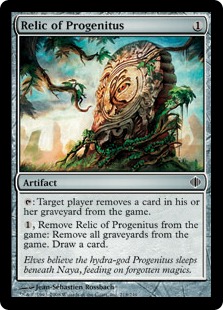 Trying to shore up disparate problems will tax your sideboard more, and leave you more vulnerable to general metagame shifts that lead to an increase in specific bad matchups.
Trying to shore up disparate problems will tax your sideboard more, and leave you more vulnerable to general metagame shifts that lead to an increase in specific bad matchups.
If you look at the evolution of Tron, you'll note it has developed around its characteristic strength against midrange and weakness to the turn-three and turn-four decks. As such, most of the deck is focused on consistently doing its thing (i.e. crushing fair decks), while particular supplemental slots are devoted to evening things up against the fast decks. Path to Exile and Collective Brutality are the most successful tools for this role in the current metagame. Tron is also generally weak to spell-based combo—once upon a time the deck featured four maindeck Relic of Progenitus, partly to hose Pyromancer Ascension. Such decks are virtually non-existent in today's Modern, allowing Tron to focus heavily on beating creature-based combo and beatdown decks. The more linear your deck is, the more this manner of deck-building should inform your approach to the format.
Silver-Bullet Hosers
Some decks don't fold so much to other strategies as to other cards. This sort of weakness also splits into a couple subcategories: namely, maindeck and sideboard hosers. We'll evaluate each separately.
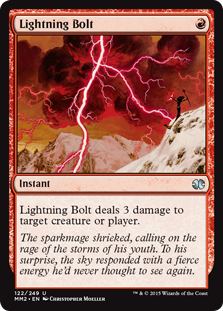 Being bad against maindeckable cards is the worst problem you can have in this regard. Let's say that your deck is bad against Lightning Bolt. That is a pretty serious problem to have, because nearly every red deck will be packing those. Grixis Delver is pretty weak to Lingering Souls, though cards that maindeck that one aren't terribly popular right now. Being weak to popular, singular maindeckable cards is arguably as bad of a problem as a deck losing to itself. For example, Izzet and Temur Delver variants have serious issues with Tarmogoyf, and that is a weakness that I simply cannot abide. If Lingering Souls were suddenly as popular as large efficient creatures, I would probably have to be off Delver. Losing to fringe stuff is much more acceptable.
Being bad against maindeckable cards is the worst problem you can have in this regard. Let's say that your deck is bad against Lightning Bolt. That is a pretty serious problem to have, because nearly every red deck will be packing those. Grixis Delver is pretty weak to Lingering Souls, though cards that maindeck that one aren't terribly popular right now. Being weak to popular, singular maindeckable cards is arguably as bad of a problem as a deck losing to itself. For example, Izzet and Temur Delver variants have serious issues with Tarmogoyf, and that is a weakness that I simply cannot abide. If Lingering Souls were suddenly as popular as large efficient creatures, I would probably have to be off Delver. Losing to fringe stuff is much more acceptable.
The other sub-category here is, of course, losing to specific sideboard cards. This is a problem that you run into the more linear your deck becomes, and is generally a bigger problem the better and more represented your deck is. Affinity players know all about this one, and they have an interesting go of determining when their deck is good and how to configure their 75. These specific sideboard hosers can sometimes be answered effectively by counter-sideboarding. Some examples of this include Dredge bringing in Nature's Claim against Leyline of the Void and Affinity bringing in Ghirapur Aether Grid against Stony Silence.
When players are under the impression that your easily-hated-out deck is on a downswing, that's often the best time to play it. This effect gets magnified when other hateable decks are competing for players' sideboard space. 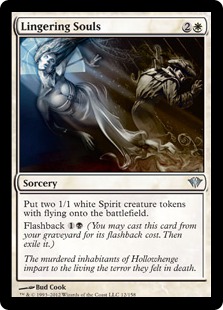 With the uptick in graveyard hate to combat Dredge right now, playing a deck like Affinity has become more attractive. On the other side of things, this significantly hurts any fringe deck trying to make use of its graveyard that can't boast the resilience and power of Dredge.
With the uptick in graveyard hate to combat Dredge right now, playing a deck like Affinity has become more attractive. On the other side of things, this significantly hurts any fringe deck trying to make use of its graveyard that can't boast the resilience and power of Dredge.
Something to pay mind to is the overlap between a weakness to a specific archetype and a weakness to a maindeckable card. For example, when I say Grixis Delver is weak to Lingering Souls, I could just as easily be saying that the deck is weak to Abzan. All other things being equal, Grixis Delver would have a dramatically better Abzan matchup if Lingering Souls never existed. As such, the difference between Jund and Abzan being the popular BGx deck matters a lot to Delver players.
Knowing Your Weakness
When selecting a deck in Modern, cataloging all of its weaknesses is the best way to determine whether or not that deck is a good choice for the metagame that you expect. For decks that lose to themselves, you want to have few if any other weaknesses. For problematic matchups or cards, you'll want to come up with a plan to defeat the most popular ones that you can reasonably expect to face in most tournaments. For some archetypes this means tinkering with maindeck flex slots, while for others it will largely be a matter of tuning your sideboard for the expected field.
Ultimately, mapping your weaknesses makes it a lot easier to look for areas where your sideboard and flex slots can be used to solve multiple problems, which is going to be a lot more effective than playing generic hosers.
Thanks for reading,
-Ryan Overturf
@RyanOverdrive on Twitter




This was a good article. I wanted to ask you a question regarding your philosophy on the deck that is your deck’s worst matchup as a general case. Do you prefer to pack a focused hate piece that can turn the matchup around but doesn’t do much against the field (if available), or do you prefer to punt on the matchup and hope to dodge it? What metagame shares (if any) would you need to be expecting to reconsider your stance on it?
This is a question that depends very heavily on context, though I’ll answer it the best that I can. The goal is to maximize your odds to make the elimination rounds, and in an event like a PPTQ this means losing at most one round. As such, I want my deck to be as well-rounded as possible. The example that I’ll use here is Grixis Delver versus Dredge. I think the matchup is very bad, and feeling good about the matchup involves heavy sideboarding. Dredge isn’t popular in my area, and as such I believe I can commit to taking the loss. Let’s say that I expect a lot of Dredge though- this means that I will need to heavily bias my sideboard to beating this deck. I’m fine doing this if I see it being relevant, though at this point I would almost prefer to just switch to a different deck, unless the popularity of Dredge means I can cut something else from my sideboard. Mostly the spectrum is that if the deck is unpopular, I’ll take the L, and if it is popular I’ll try to bias heavily or will consider major changes to my deck selection.
So say you are weak to an archetype. Let’s say “fair” creature combo (infect, deaths shadow, kiln etc)
Let’s say those matchups are very hard for your deck. If, post sideboard, it’s still not particularly good, do you think that it is better to simply double down on beating what you beat and accept an archetypal bad matchup?
I’ve been thinking about this lately. I haven’t won any post board games against infect (and likely the same vs shadow etc) with my favorite deck. The sideboard helps but not enough to equalize.
I’m considering to not bother with sideboarding for that whole archetype so I can almost guarantee a win vs control, aggro, spell combo, and big mana.
With a singular deck it makes sense to not bother and hope to dodge but an archetype?
I would say that if heavy sideboarding can’t make you favored, it’s not worth the slots. Either refocus on shoring up your positive matchups or improving closer ones. The reality is that if those decks end up being a heavy share of the metagame and you’re barely even with them with heavy sideboarding, you’re likely better switching decks.
Thanks for the answer. This was very informative for me. I’m employing a similar philosophy against Affinity as Merfolk.
I love these types of articles. Help you understand successful mindsets and truly how to become better as opposed to simple things like what sideboard card.
Expanding understanding is a permanent improvement, and I attribute these articles to almost all of my mediocre success in modern (mediocre is better than none, which is where I would’ve been)
This article clarifies a lot of what I do as a DnT pilot. just due to the nature of the deck, there are a lot of knobs to turn to prepare for differing metas. The cost of this is that you are always weak to something. being able to identify what any given build of my deck is weak to and, should I chose to do so, how I can prepare for that weakness is how I’ve found both a lot of success and a lot of failure with the deck. Understanding your shortcomings really is quite the art.
another excellent article. This is something i have been reading into more as I get more serious personally in the modern format. For a good example of this, I love playing black white tokens. This deck isn’t particularly popular right now, but the deck is fairly powerful and the draw are consistent and powerful, and the deck has very few bad matchups. Combo decks get eaten alive by all of our hate, specifically anguished unmaking exiling their leyline and following up with lost legacy (naming ad naseum, living end, or just playing out rest in peace), and tron cant handle surgical extraction, ghost quarter, and hand hate. However, The deck has a serious problem when running into straight up hard jeskai control, the burn matchup, or any of the nahiri control decks. We don’t apply pressure fast enough to kill nahiri consistently on the draw, the burn matchup is actually laughable even with 2 timely and 2 shambling vent and 3 sorin post board, and hard jeskai control just buries us in cards. So sadly, the deck cannot be taken to any serious tournament, with R/W prison and jeskai nahiri as popular as they are (along with burn always seeming to find me round 1 EVERY time). Dredge and infect fold pretty handily to the sideboard and sheer removal, and we out midrange the midrange decks pretty handily. It certainly is an undervalued skill in modern to know what you’re bad against and be willing to admit that, even if it is your favorite deck.